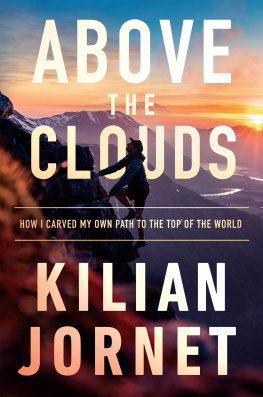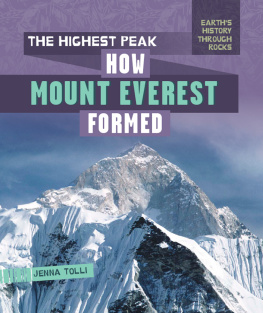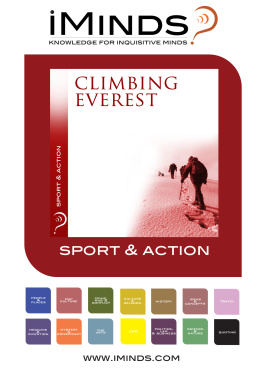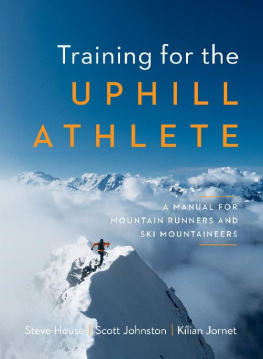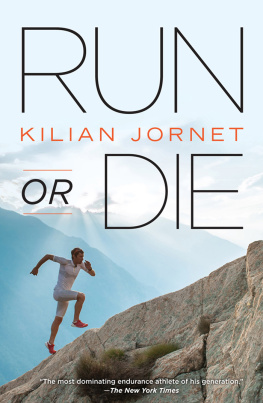I ts not like I woke up one morning with some transcendental resolution to start running.
Ive been running mountains since the very beginning of my life, and since then I have spent my days counting the blueness of the lakes, the sharpness of the ridges, the length of the sunsets, and, well, some boring stuff like meters climbed and the miles behind and in front of me.
I wasnt like most kids growing up. The posters in my childhood bedroom were of Matterhorn, the Toblerone mountain in Switzerland, and a panorama called the Roof of the World, showing the range of Everest and the surrounding mountains. Eventually I climbed Matterhorn, and sometime after that I climbed Everest. When I ran up and down Matterhorn, it was to break a record, but Everest was different. I approached Everest with the idea to try a new way of mountain climbing. Four years separated my climb of Matterhorn and Everest, but mostly what separated them was my realization that I was living a life of contradictions. I ran fast to live a slow lifestyle. I needed solitude to be myself and social interactions to make a living. I loved the adrenaline of a race and the calm of the world above 8,000 meters. I enjoyed discovering remote mountains, but to protect them, I now realize it might have been better if I hadnt visited them at all. I am those contradictions, and how I deal with them is also who I am. There will always be consequences to my actions, positive or negative, and those consequences might affect only myself or affect a large amount of people.
As a teenager, I learned how to race in the mountains. It is all about training, getting in shape, executing the perfect movements, but beyond the physical, it is about how a runner or climber sees the mountains. Are they merely a playground to race on? Are they a stadium on which to perform your sport? Or are they something else entirely?
When I climbed Matterhorn, I viewed mountains as my playground, the source of my greatest joy and fun and pleasure, and as my stadium, where I competed. Then, after some encounters with a few special humans youll read about in these pages, the fury of the mountains emerged in my life, and my stadium started to fall apart. Competition in sports is about performance. The time on the clock. When you cross the finish line. When your competitors do the same. In federated sports, this performance is judged by rules and regulations. But in the mountains, these rules and regulations are meaningless. Mountains are (still) a space of freedom, where lawlessness reigns for the good of everyone.
DIDIER DELSALLE HAS BEEN ON TOP OF EVEREST. ON MAY 14, 2005, HE landed with his helicopter on the 8,848-meter summit. If he told you that he reached the summit of Everest, he wouldnt be lying, although most of us in the mountain-climbing world would disagree. But where is the line we can draw between achieving the greatest featreaching the summitand climbing the distance to get there? How many steps are considered effort enough to claim an ascent? What Ive learned is that every shortcut is a personal decision you must live with, and every achievement is the same.
When it comes to climbing mountains, the reaching should never compromise the journey to get there. Thats why when I climbed Everest, I did it alone with no assistancenot to simply step on the summit but to see what I was able to endure in my journey getting there. Four years before, when I ran up and down Matterhorn faster than anyone before, I was obsessed only with the achievement, researching the past, emulating how the fastest person before me had done it, and using his rules, as it was a competition. I was racing him. On Everest, I raced myself.
When I started traveling far to do a run or a race or a climb, I considered it just a part of the job. But today Im questioning how much of that travel is making a negative impact on the natural world I love so much. Does the answer Because thats just how it is make it okay? In the long run, climbing Everest has likely been a very selfish and absurd activity, but what I understand from writing this book is that the path I have taken to climb it and the encounters I have had on that road have changed the way I see not only the mountain but also myself, and the connection between humans and nature has made me, I hope, a more committed human with those contradictions. Throughout these pages I try to explain this journey.
In the end, Above the Clouds is not about what I have achieved but about what I have experienced, about feeling at peace with my values when I do something and embracing the possibility of change and failure as a reward for my soul.
M y lips said I love you when what they really wanted to admit was Im sorry.
I kept forcing the words out, trying to make excuses: Dont worry, Ill be careful... but I knew no excuse would seem reasonable to her for setting out on an adventure that could lead to my death on the worlds highest mountain. Yet I need to climb mountains to feel alive, even if I risk death.
I managed to mumble, Goodbye, with an uneasy feeling that I was being selfish and narcissistic. I definitely am those things. I took my backpack out of the trunk, accidentally slamming the lid shut. Dazed by the sudden loud noise, and this strange silence between us, I finally tapped on the back windshield to let her know she could leave.
IT WAS EARLY AUGUST, BUT THE AIR WAS BRISK. THE SCENT OF THE sea filled my lungs. Troms is a fishing port on a little island surrounded by fjords and mountains, above the Arctic Circle in northern Norway. For a few weeks in summer, the sun doesnt set; its always daytime. Its as if time means nothing: grandparents go out for a midnight stroll, and you can see your neighbors fixing their balconies or tiling their roofs in the wee hours of the morning. A collective drunkenness seems to take hold of the region for a single, never-ending day. But the sun is gentle and never rises high in the sky, doing circles above the horizon, painting it with a thick layer of pastel colors, yellow and orange tones, sometimes flooded with intense red.
The airport, where I said goodbye to the woman I love, lies at one end of the island. As Emelie drove away, I blew her a silent kiss. I didnt want to look back, so I walked into the airport, trying to let my eyes dry before I went up to the check-in desk. I was setting out on a journey that would take me to the summit of Everest, aware of the difficulties and dangers that lay ahead. Despite everything, at no point did I reconsider this decision.
A FEW HOURS EARLIER, EMELIE AND I HAD GONE FOR A RUN TOGETHER. Taking advantage of the continual light, we went out at night, after dinner, to stretch our legs and clear our minds after a tense and stressful few days of organizing a race for a few hundred runners. In the last few days, the phone calls, car rides back and forth, and hand squeezes had been near constant. Running together, just the two of us, would be a much-needed cleansing exercise.
We set off along a narrow path, leaving the noise of the city behind. We wanted the mountains to shelter us. The winds soft murmur replaced the radio programs floating out of the houses and shops in town, and a pure, fresh breeze replaced the stifling air among the crowds and the smoke. Gradually, our legs began to feel lighter and lose the stiffness of the last few days. We climbed to the top of the first peak and ran on without stopping. We left the dirt path for the fields, climbing a new route. The frosty grass soaking our feet contrasted with the hard, dry surface of the black asphalt. Little by little, our hearts began to beat at a shared rhythm, echoing the thump of our steps.
We ran side by side, steeped in a feeling of peace and serenity that contrasted with the whirlwind of the previous days. But happiness cant continue forever; this calm was the prelude to our farewell. Though from time to time we opened our mouths to try to say what needed to be said between us, sound didnt emerge.


